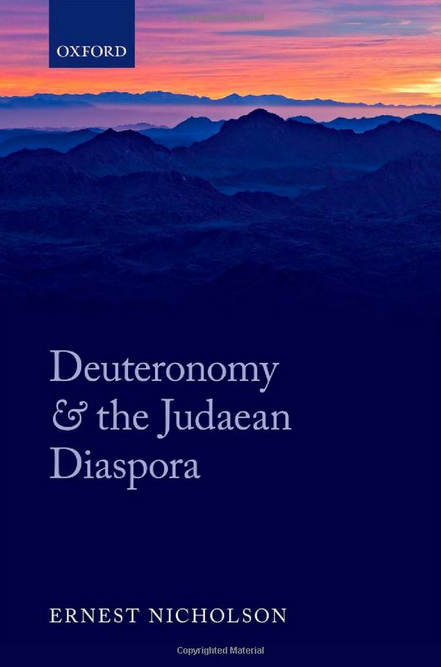Ernest Nicholson’s latest work builds on his previous research concerning the development of Deuteronomy (Dt) and the Deuteronomistic History (DtrH). The book is divided into two parts. Part one is concerned with a re-evaluation of the provenance of Dt and DtrH. Part two focuses on the question: “Is DtrH history / historiographical?”
Part one develops the thesis that the majority of Dt was written during the Babylonian exile. First, Nicholson challenges the scholarly consensus that Dt was the “book of the torah” discovered during the reign of Josiah (2 Kings 22.8-13). There is evidence of Deuteronomistic redaction in 2 Kings 23.8-9, and so the historicity of the account is questionable. The Babylonian Exile, rather than some period before the reforms of Josiah, is a more plausible provenance for Dt. Second, the major themes of Dt are the encroachment of foreign gods, threats from foreign powers, and the persistent problem that Israel will lose her identity. These concerns are reflected in the commands throughout Dt to avoid foreign pollution, to revere a central cultic site, and to remember God and his Torah. Again, the Babylonian Exile is the best explanation for this situation. Third, this period also saw the rise of prophecy as the exiles sought to make sense of their contemporary situation. Dt regards Moses as the “first of the prophets,” and this gave authority to a growing body of prophetic literature written in the same period. Fourth, this is further substantiated when the laws concerning kings are considered. Dt 17.14-20 which appears as a set of laws is actually an editorial critique of Israel’s monarchy. By design, it “casts a long shadow ahead of itself” on the narrative that follows (pg 116). Dt 17.15 prohibits the granting of the monarchy to a foreign king. Again, an exilic provenance is considered the best explanation. All of these lines of evidence lead to, and at times build from, the conclusion that Dt and the DtrH were composed in large part after the collapse of the monarchy and during the Babylonian Exile.
In part two Nicholson revisits the question of whether or not DtrH can be considered historiography in the modern sense of the term. He argues that DtrH cannot be considered history based on three main points. First, given the Exilic provenance established in part one, the authors of DtrH are not concerned with recent events. Second, the authors cannot therefore be concerned with empirical evidence, particularly the testimony of eyewitnesses. Third, DtrH gives explanations for why things happen that are, by definition, non-historical, namely the attribution of divine causation. Nicholson writes, “there is no intellectually serious conception of history that resorts to divine agency as a mode of explanation” (pg. 140). Therefore DtrH is theodicy and not history. His main conversation partner in this section is John Van Seters, and the second essay is a direct response to Van Seters that essentially re-states the above three points.
In part one Nicholson is working from well within the sphere of traditional critical OT scholarship, and so many of his starting assumptions are unstated or simply assumed. For this reason, many conservative readers may find his final conclusions difficult to accept. Nevertheless, his insights on specific points are still very helpful. In particular, Nicholson helps the reader to understand the significance DtrH would have had in an exilic context, regardless of when it was actually written. Those who share Nicholson’s critical assumptions will also have their assumptions challenged. His conclusions regarding the provenance of Dt challenge a wide consensus concerning the role of the reforms of Josiah and the subsequent monarchy. This will no doubt generate helpful discussion.
Section two recapitulates a very old debate over the historicity of the OT. Nicholson’s first two points rest on his conclusions about the provenance of the text. If DtrH is quite late then his point is certainly made. If not, then the point is far less certain. Further, when one considers all of the authorial and redactional layers found in Dtr it is difficult to conclude with certainty that the corpus as a whole is not concerned with recent history and empirical accounts. The negative conclusions about historical possibilities are notoriously difficult to substantiate. Finally, some theists may take great umbrage with the characterization that resorting to divine agency as an explanation is “no intellectually serious conception of history.”
As always, Nicholson’s work is innovative, insightful, and challenging. As in his previous work, he helpfully makes available to a wider readership material that otherwise might have been inaccessible, especially for those who cannot read German. His considerable scholarly abilities are also self-directed. The five essays that make up part one were all previously published in Zeitschrift für die Alttestamentliche Wissenschaft, but each of these has been reworked and significantly modified. Nicholson freely admits that his new conclusions are, at times, significantly different from those he had reached previously. For this reason alone, the present volume is a must-read for those interested in Nicholson’s previous work. It is also very helpful to observe how a seasoned scholar is able to revisit his own work and come to new conclusions. The willingness to do so should be seriously commended. Students of the Old Testament have much to learn not only from Nicholson’s conclusions and methodology, but also the humility with which he approaches these two spheres.
Bottom Line: In Part Two, Nicholson challenges accepted conclusions about the provenance of Deuteronomy, arguing that it was largely composed during the Babylonian Exile rather than before Josiah’s reforms. In Part Two, He also reasserts that the Deuteronomistic History is not history in the modern sense, but rather must be considered theodicy. A must read for any student of Deuteronomy, the Deuteronomistic History, or Nicholson’s previous work.
Review by Raymond Morehouse





Leave a Reply
Your email is safe with us.